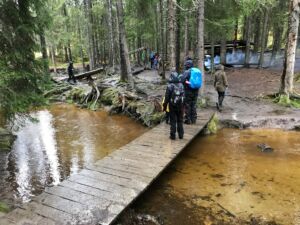Location: Greater Oslo Metropolitan area, Norway
Lead partners: NINA, OOF
In this case study, our goal is to advance inclusive outdoor recreation that not only protects biodiversity but also enhances accessibility to nature for socially excluded groups. We aim to identify necessary adjustments to provide children with disabilities with improved access to enriching nature experiences. We explore the reasons behind the limited time children with disabilities seem to spend in nature and their lower participation in organised nature activities. Our goal is to uncover both social and tangible factors that could enhance their inclusion and engagement with nature.
Furthermore, we assess how well current mapping and national valuation methods reflect the value of recreational areas for children and people with disabilities. We also examine how effectively municipalities in the greater Oslo area incorporate this data into their urban development and planning.
The Oslo metropolitan area is home to Norway’s highest species diversity, but also the country’s largest urban population, densification and large shifts in cultural and socio-demographics.
Pandemic lockdowns, climate change, migration and social media are global drivers changing historical use patterns of near urban nature areas.
NINA (Norwegian Institute for Nature Research) and OOF (Greater Oslo Recreation Council) collaborate in exploring participatory methods to enable outdoor recreation activities across a wider range of individual (dis)abilities, while promoting stewardship and safeguarding of local biodiversity. The research is focusing on (dis)abilities for physical activity in nature and youth.

Photo: Juliet Landroe / NINA
Expected impacts
Biodiversity
Recognising the values of natural areas in Greater Oslo enhance caring and protection for biodiversity.
Individual level
The initiative supports discovering new ways to interact with nature, learning from young people with disabilities and opening stakeholders’ minds.
Community level
The landscape and urban planning bodies within the local and national government learn and apply innovative approaches to urban planning: assumptions made around the needs of children with disabilities in nature.
Institutional/Policy level
Resulting recommendations will be shared as input to revision of municipal methods for mapping and valuation of recreation areas coordinated by the Norwegian Environment Agency. Specific recommendations will be given on standardising description and mapping of recreational qualities of nature of importance for young people and people with disabilities.
Intersectionality dimensions
Age: young people (6-19 years)
Disabilities

Photo: Jørn Fremstad / NINA
Working approach
National survey to parents with children and youth (age 6-19 years) to gain insights into how children with disabilities use natural, outdoors areas, and identifying barriers to using them.
Mapping of organisations involved, qualitative interviews with organisations dedicated to outdoor recreation and nature experiences for children, discussions about challenges/possibilities for interventions.
Participant observation at different outdoor events and arrangements.
Exploring possible interventions for enhancing accessibility to enriching nature experiences for children and young people with disabilities together with experts on being young, living with disabilities and making outdoor nature recreation inclusive of their peers.
Photography, asking children to share images of their favourite outdoor areas and recreational grounds (is it on their doorstep or is it inaccessible to them? Which elements of nature are most important to them?)
Survey and interviews of municipalities on the recreation area mapping results.
Analysis and data collection to address assumptions of what disabled people need, what they can/can’t do in the recreational space.
Research-based discussions, synthesising facts/case outcomes.
Publications
Results from three national surveys were presented in a recent thematic report that highlights the trends in outdoor play among children (6-12 years) and recreation in nature among youth (12-19 years) from 2013 to 2023. Of special interest is the amount of time spent playing and recreating outdoor in nature before-during-after the Covid-19 pandemic. The results from the surveys showed an alarming decreasing trend of outdoor play, especially in natural settings.
Wold, L.C., Gundersen, V. & Vistad, O.I. 2024. Bli med ut og lek! Hva skjedde under koronaperioden?
NINA Temahefte 91. Norsk institutt for naturforskning. NINA Brage: Bli med ut og lek! Hva skjedde under koronaperioden?
The research on childrens’ outdoor play and recreation got high attention in multiple media channels. We refer here to a presentation at the main research media site in Norway.
Forskning.no Barn leker stadig mndre i naturen: – Alarmerende (forskning.no)
